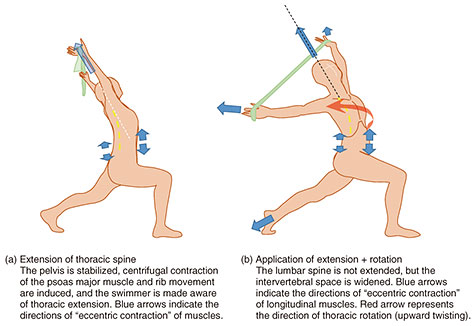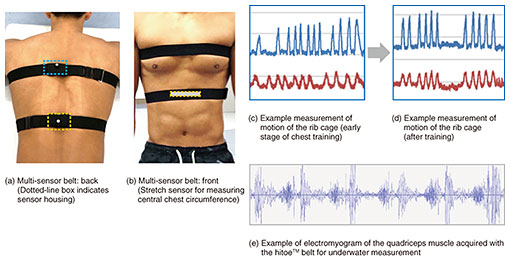 |
|
|
|
|
|
Feature Articles: 2021 International Sporting Event and NTT R&D—Technologies for Supporting Athletes Vol. 20, No. 2, pp. 44–50, Feb. 2022. https://doi.org/10.53829/ntr202202fa5 Swimming × Online Coaching: Online Conditioning of Competitive Swimmers—Focusing on the Thorax—via Smartphones and Wearable SensorsAbstractIn response to the decline in motor function (centered on the thorax) caused by chronic muscle tension associated with strengthening exercises for competitive swimmers, we devised a training program that promotes awareness of the functional coordination of the thorax; spine, ribs, and core muscles, and restores natural and efficient body movement. This article presents the results of supporting athlete training during the novel coronavirus pandemic by providing regular coaching remotely using a web-conference system with smartphones, video recording, and a multi-sensor belt equipped with hitoe™ for measuring myoelectricity, respiration, and motion. Keywords: online core training, wearable sensor, hitoe™ 1. Background and targetFor Japanese athletes to achieve success in international competitions, it is necessary to strengthen their overall physical fitness, including sufficient muscle strength and energy metabolism to compensate for the difference in body size compared with non-Japanese athletes. Satisfying this requirement requires long-term, high-intensity training. Athletes who have undergone long-term strengthening exercises have suffered from joint pain, stiffening of developed muscle groups, and limited range of motion¡½all caused by accumulated fatigue and damage¡½that have resulted in poor performance and disappointing results. Regardless of the athletic discipline, pain and limited range of motion are not limited to the major joints of the extremities and their regions; they can also be found in the thoracic spine, thoracolumbar junction, costovertebral joints, intercostal muscles, and around the shoulder girdle (Fig. 1). These parts are remote from the major muscles and joints, so they are easily overlooked. However, for swimmers, the effects of limited range of motion and pain due to chronic muscle tension in these parts can lead to increased water resistance in the streamline position due to poor posture, such as the compensatory lumber hyperextension. It has also been a concern that such pain and limited motion could affect overall performance because they could limit the expansion of the thorax (ribs), which is associated with breathing. To address this issue, we have been supporting competitive swimmers through regular conditioning to alleviate functional limitations and distortions of the joints and muscles around the thorax, evaluation using biometric sensors and video, and online coaching via a smartphone.
The target swimmers, whose training base is at the swimming club of Chukyo University (head coach: Yuichiro Sasaki), were Takeshi Kawamoto (Toyota Motor) and Ai Soma (MIKI HOUSE) who have both won top prizes in domestic competitions and participated in international competitions (butterfly sprint). The pre-intervention subjective symptoms were chronic back muscle tension (Fig. 2(a)), middle back pain, and hardness of the thorax during breathing. The objective symptoms were restrictions in all directions throughout the thorax, excessive contraction of muscles around the scapula and erector spinae muscles, and a tendency of lumber hyperextension. In terms of whole-body coordination, the limited extension range of motion of the thoracic spine and hyperextension of the cervical spine and lumbar-sacral junction during whole spine extension in the prone position were observed (Fig. 2(a)). Limited range of motion of spine extension was also confirmed in the back line (side view) in the streamline position (Figs. 2(c) and (d)). Similar symptoms re-occurred due to intensive strengthening practice.
2. Concept of coachingThe thorax is a three-dimensional structure consisting of stacked vertebrates of the thoracic spine, each of which is connected to a pair of ribs on the left and right sides, which are joined by many joints and act like a suspension. The thorax is an important part of the body that fine-tunes the movements of the whole body. Accordingly, instead of focusing on simply gaining flexibility, we thus focused on how to enhance its function in coordinating the whole body. First, the whole body is prepared to work as one by co-contracting the components of the inner unit (i.e., diaphragm, multifidus, transversus abdominis muscles, and pelvic-floor muscles). The swimmers were trained to move their ribs and the linkage of the rib cage voluntarily when moving the whole body. By the swimmers self-checking the movement of their ribs by watching a video during the movement and repeating self-correction with attention (Fig. 3), it became possible to move involuntarily in the correct manner.
3. Actual coachingFollowing the step-by-step exercise plan listed below, individualized hands-on and online coaching, lasting approximately 45 minutes once every 1 to 2 weeks, was provided to the swimmers. The basic movements were first limited to those around one axis, and only one part of the body was moved to make it easier for the swimmers to become aware of it. After the movements that separate the stabilizing part (lumbar pelvis) from the ribs (thorax) were learnt, the number of moving parts was gradually increased to two or more. The number of planes and axes of movement were then increased. The swimmers increased their endurance by changing their posture while applying their body weight, performing the movements under unstable conditions, and changing the speed at which they moved. (1) Awareness of inner unit (i.e., body axis) The swimmers were coached to correctly understand their inner unit (i.e., pelvic-floor muscles, transversus abdominis muscles, multifidus muscles, and linked diaphragm). While maintaining the stability of the lumbar pelvis and checking their awareness of breathing and the contraction of the transversus abdominis muscles, the swimmers slowly repeated smooth movement of the hip joints. This procedure is done in supine, sitting, all-fours, and standing positions. (2) Relationship between rib movement and inner unit The swimmers were coached to understand the basic movements of their ribs (associated with thoracic-spine flexion, extension, lateral flexion, and rotation) by placing their hands on their ribs and performing self-tactile movements (i.e., self-correcting and guiding body movements). While keeping the lumbar pelvis stable, the swimmers moved their ribs while maintaining awareness of their breathing and understanding the relationship of that movement to the area of the rib cage into which the thorax expands (Fig. 4).
(3) Consciously move the spine, shoulder joints, hip joints, and other parts of the body in a state of whole body connection The swimmers were instructed to maintain a state of whole body connection (a state in which awareness of the inner unit, hip-joint stability, shoulder-blade stability, abdominal and back muscles, etc. are all connected and controlled) and to link the whole body while maintaining awareness of rib movement (Figs. 5 and 6).
4. Video evaluation of thorax function and biometric measurement using wearable sensorsWe created a multi-sensor belt (for research) equipped with hitoe™ electrodes for myoelectric measurement, 9-axis motion sensors (i.e., 3-axis acceleration, 3-axis gyro, and 3-axis orientation measurements), and a stretch sensor for measuring expansion and contraction of the chest girth during respiration for measuring the swimmers¡Ç bodies. The data were transferred to the smartphone via BLE (Bluetooth Low Energy) and stored in the internal memory of the smartphone (Fig. 7). A dedicated hitoe™ belt (waterproof and multi-sensor type; for research) was used for underwater measurement of electromyograms, heart rate, and motion (Fig. 7(e)).
5. Evaluation of thorax function with swimmers in streamline positionEase of breathing and arm raising were evaluated on a five-point self-assessment scale before and after the above-stated exercise plan. The degree of thorax expansion during respiration in the streamline position was also measured (i.e., continuous measurement of chest girth) by using the stretch sensor of the multi-sensor belt. The changes in the streamline position before and after the exercise were photographed from three directions and evaluated. The results indicate that the ease of breathing and arm raising increased by one to two levels (on a five-point self-assessment scale) after the planned exercise. Over the course of the postural changes, we found that initially, the swimmers had a tendency toward lumber hyperextension and extension of the thoracolumbar junction; however, this tendency also gradually improved (Figs. 2(b) and (e)). 6. Online coaching using video conferencing via smartphonesDue to the novel coronavirus (COVID-19) pandemic, the international sporting event due to be held in 2020 was postponed for one year. Accordingly, to prevent the spread of COVID-19 infections, access to Chukyo University, the main training site, and swimming facilities where training camps were held was restricted. To continue regular conditioning of the swimmers, we switched from on-site hands-on instruction to online coaching via a smartphone video-conferencing system. Since the swimmers had already mastered the basic movements through hands-on coaching, we gradually upgraded the adjustments and techniques used in the online instruction by (i) determining the current state of the swimmers through dialogue and the above-mentioned evaluation indicators as well as their body movements from the video images and (ii) adjusting the coaching content accordingly. Conditioning through online coaching was helped by the motivation of the swimmers and continued until the main competition in 2021 over a period that included overseas expeditions and training camps. 7. DiscussionSwimmers must maintain a streamline position to ensure lower resistance while moving through the water. As well as achieving sufficient range of motion of the shoulder joint, they must satisfy two requirements: (i) coordination of many muscles involved in thoracic extension, especially control of the small muscle groups (local muscles) at the deep segmental level of the spinal column (such as multifidus and rotator muscles) and (ii) sufficient elongation of the peri-scapula muscles, erector spinae muscles, breathing-related muscles, latissimus-dorsi muscles, abdominal oblique muscles, etc. (collectively known as the global muscles). It has been suggested that as a result of high-intensity training, stress concentrates on relatively fragile structures and tissues through fatigue or injury. This concentration of stress then triggers local inflammation and pain, which creates a vicious cycle through the neuromuscular and vascular control systems, resulting in chronic pain and impaired functions. Regular conditioning focused on the rib cage can effectively bring out the natural functions of this area while making the swimmer aware of the connection of the whole body and their overall condition. Takeshi Kawamoto set a new personal best in the 50-m butterfly at the Japan Championships and competed as a member of the 100-m-butterfly team at the target international sporting event in 2021. Ai Soma won the 50-m and 100-m butterfly at the Japan Short Course Championships. Knowing that athletes need to strengthen their physical, technical, and mental strength while coping with fatigue and potential dysfunction associated with rigorous training, we will continue to support them by enhancing recovery and conditioning techniques. |
|

















